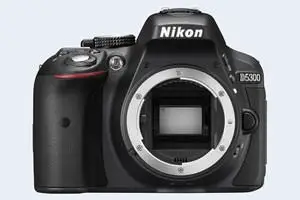Nikon D5200 vs D5300
The Nikon D5200 and the Nikon D5300 are two digital cameras that were officially introduced, respectively, in November 2012 and October 2013. Both are DSLR (Digital Single Lens Reflex) cameras that are equipped with an APS-C sensor. Both cameras offer a resolution of 24 megapixels.
Below is an overview of the main specs of the two cameras as a starting point for the comparison.

Check D5200 offers at
ebay.com

Check D5300 offers at
ebay.com
Going beyond this snapshot of core features and characteristics, what are the differences between the Nikon D5200 and the Nikon D5300? Which one should you buy? Read on to find out how these two cameras compare with respect to their body size, their imaging sensors, their shooting features, their input-output connections, and their reception by expert reviewers.
Body comparison
An illustration of the physical size and weight of the Nikon D5200 and the Nikon D5300 is provided in the side-by-side display below. The two cameras are presented according to their relative size. Three successive views from the front, the top, and the rear are shown. All width, height and depth dimensions are rounded to the nearest millimeter.
The D5200 can be obtained in two different colors (black, red), while the D5300 is available in three color-versions (black, grey, red).
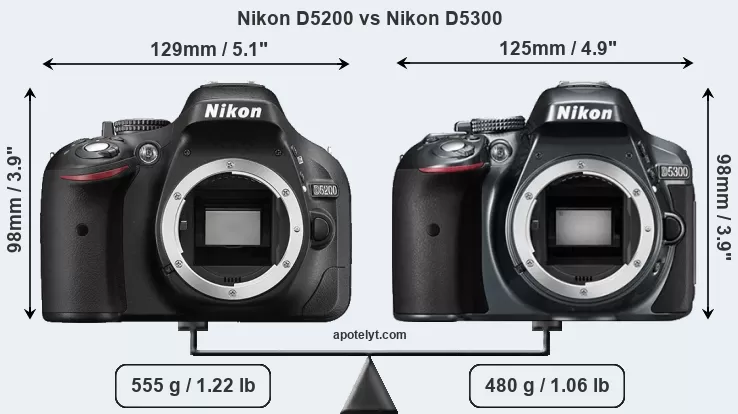

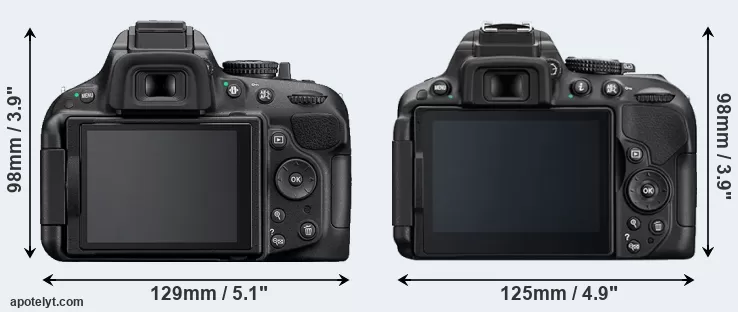
If the front view area (width x height) of the cameras is taken as an aggregate measure of their size, the Nikon D5300 is somewhat smaller (3 percent) than the Nikon D5200. Moreover, the D5300 is markedly lighter (14 percent) than the D5200. In this context, it is worth noting that neither the D5200 nor the D5300 are weather-sealed.
The above size and weight comparisons are to some extent incomplete since they do not consider the interchangeable lenses that both of these cameras require. In this particular case, both cameras feature the same lens mount, so that they can use the same lenses. You can compare the optics available in the Nikon Lens Catalog.
Concerning battery life, the D5200 gets 500 shots out of its Nikon EN-EL14 battery, while the D5300 can take 600 images on a single charge of its Nikon EN-EL14a power pack.
The following table provides a synthesis of the main physical specifications of the two cameras and other similar ones. If you would like to visualize and compare a different camera combination, you can navigate to the CAM-parator app and make your selection from a broad list of cameras there.

| Camera Model |
Camera Width |
Camera Height |
Camera Depth |
Camera Weight |
Battery Life |
Weather Sealing |
Camera Launch |
Launch Price |
Street Price |
||
|---|---|---|---|---|---|---|---|---|---|---|---|
| 1. | Nikon D5200 | 129 mm | 98 mm | 78 mm | 555 g | 500 | n | Nov 2012 | US$ 749 | ebay.com | |
| 2. | Nikon D5300 | 125 mm | 98 mm | 76 mm | 480 g | 600 | n | Oct 2013 | US$ 799 | ebay.com | |
| 3. | Nikon D60 | 126 mm | 94 mm | 64 mm | 522 g | 500 | n | Jan 2008 | US$ 629 | ebay.com | |
| 4. | Nikon D3200 | 125 mm | 96 mm | 77 mm | 505 g | 540 | n | Apr 2012 | US$ 599 | ebay.com | |
| 5. | Nikon D3300 | 124 mm | 98 mm | 76 mm | 430 g | 700 | n | Jan 2014 | US$ 499 | ebay.com | |
| 6. | Nikon D3400 | 124 mm | 98 mm | 76 mm | 445 g | 1200 | n | Aug 2016 | US$ 499 | ebay.com | |
| 7. | Nikon D5000 | 127 mm | 104 mm | 80 mm | 590 g | 510 | n | Apr 2009 | US$ 749 | ebay.com | |
| 8. | Nikon D5100 | 128 mm | 97 mm | 79 mm | 560 g | 660 | n | Apr 2011 | US$ 749 | ebay.com | |
| 9. | Nikon D5500 | 124 mm | 97 mm | 70 mm | 470 g | 820 | n | Jan 2015 | US$ 899 | ebay.com | |
| 10. | Nikon D5600 | 124 mm | 97 mm | 70 mm | 465 g | 970 | n | Nov 2016 | US$ 699 | ebay.com | |
| 11. | Nikon D7100 | 136 mm | 107 mm | 76 mm | 765 g | 950 | Y | Feb 2013 | US$ 1 199 | ebay.com | |
| Note: Measurements and pricing do not include easily detachable parts, such as add-on or interchangeable lenses or optional viewfinders. | |||||||||||
Any camera decision will obviously take relative prices into account. The manufacturer’s suggested retail prices give an idea on the placement of the camera in the maker’s lineup and the broader market. The D5200 was somewhat cheaper (by 6 percent) than the D5300 at launch, but both cameras fall into the same price category. Normally, street prices remain initially close to the MSRP, but after a couple of months, the first discounts appear. Later in the product cycle and, in particular, when the replacement model is about to appear, further discounting and stock clearance sales often push the camera price considerably down.
Sensor comparison
The size of the imaging sensor is a crucial determinant of image quality. A large sensor will tend to have larger individual pixels that provide better low-light sensitivity, wider dynamic range, and richer color-depth than smaller pixel-units in a sensor of the same technological generation. Further, a large sensor camera will give the photographer additional creative options when using shallow depth-of-field to isolate a subject from its background. On the downside, larger sensors tend to be associated with larger, more expensive camera bodies and lenses.
Both cameras under consideration feature an APS-C sensor and have a format factor (sometimes also referred to as "crop factor") of 1.5. Within the spectrum of camera sensors, this places the review cameras among the medium-sized sensor cameras that aim to strike a balance between image quality and portability. Both cameras have a native aspect ratio (sensor width to sensor height) of 3:2.
Technology-wise, the D5300 uses a more advanced image processing engine (EXPEED 4) than the D5200 (EXPEED 3), with benefits for noise reduction, color accuracy, and processing speed.
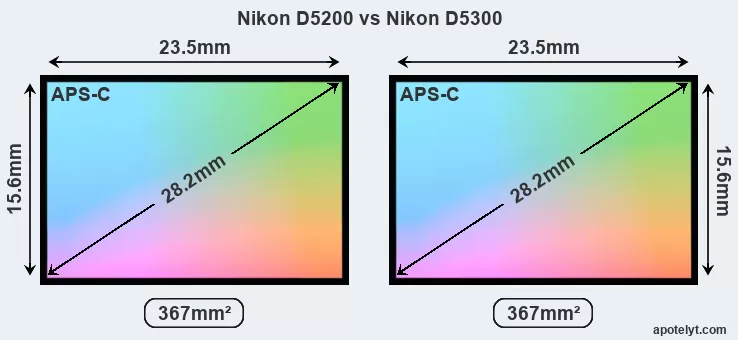
The two cameras under review do not only share the same sensor size, but also offer an identical resolution of 24 megapixels. This similarity in sensor specs implies that both the D5200 and the D5300 have the same pixel density, as well as the same pixel size. It should, however, be noted that the D5300 is a somewhat more recent model (by 11 months) than the D5200, and its sensor might have benefitted from technological advances during this time. Coming back to sensor resolution, it should be mentioned that the D5300 has no anti-alias filter installed, so that it can capture all the detail its sensor resolves.
The Nikon D5200 has a native sensitivity range from ISO 100 to ISO 6400, which can be extended to ISO 100-25600. The corresponding ISO settings for the Nikon D5300 are ISO 100 to ISO 12800, with the possibility to increase the ISO range to 100-25600.
Technology-wise, both cameras are equipped with CMOS (Complementary Metal–Oxide–Semiconductor) sensors. Both cameras use a Bayer filter for capturing RGB colors on a square grid of photosensors. This arrangement is found in most digital cameras.
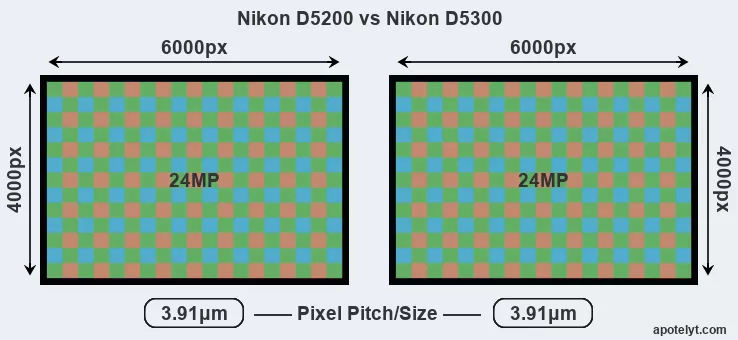
For many cameras, data on sensor performance has been reported by DXO Mark. This service is based on lab testing and assigns an overall score to each camera sensor, as well as ratings for dynamic range ("DXO Landscape"), color depth ("DXO Portrait"), and low-light sensitivity ("DXO Sports"). The Overall DXO ratings for the two cameras under consideration are close, suggesting that they provide similar imaging performance. The adjacent table reports on the physical sensor characteristics and the outcomes of the DXO sensor quality tests for a sample of comparator-cameras.

| Camera Model |
Sensor Class |
Resolution (MP) |
Horiz. Pixels |
Vert. Pixels |
Video Format |
DXO Portrait |
DXO Landscape |
DXO Sports |
DXO Overall |
||
|---|---|---|---|---|---|---|---|---|---|---|---|
| 1. | Nikon D5200 | APS-C | 24.0 | 6000 | 4000 | 1080/60i | 24.2 | 13.9 | 1284 | 84 | |
| 2. | Nikon D5300 | APS-C | 24.0 | 6000 | 4000 | 1080/60p | 24.0 | 13.9 | 1338 | 83 | |
| 3. | Nikon D60 | APS-C | 10.0 | 3872 | 2592 | none | 22.5 | 11.4 | 562 | 65 | |
| 4. | Nikon D3200 | APS-C | 24.1 | 6016 | 4000 | 1080/30p | 24.1 | 13.2 | 1131 | 81 | |
| 5. | Nikon D3300 | APS-C | 24.0 | 6000 | 4000 | 1080/60p | 24.3 | 12.8 | 1385 | 82 | |
| 6. | Nikon D3400 | APS-C | 24.0 | 6000 | 4000 | 1080/60p | 24.8 | 13.9 | 1192 | 86 | |
| 7. | Nikon D5000 | APS-C | 12.2 | 4288 | 2848 | 720/24p | 22.7 | 12.5 | 868 | 72 | |
| 8. | Nikon D5100 | APS-C | 16.1 | 4928 | 3264 | 1080/30p | 23.5 | 13.6 | 1183 | 80 | |
| 9. | Nikon D5500 | APS-C | 24.0 | 6000 | 4000 | 1080/60p | 24.1 | 14.0 | 1438 | 84 | |
| 10. | Nikon D5600 | APS-C | 24.0 | 6000 | 4000 | 1080/60p | 24.1 | 14.0 | 1306 | 84 | |
| 11. | Nikon D7100 | APS-C | 24.0 | 6000 | 4000 | 1080/60p | 24.2 | 13.7 | 1256 | 83 |
Many modern cameras are not only capable of taking still images, but can also record movies. The two cameras under consideration both have sensors whose read-out speed is fast enough to capture moving pictures, but the D5300 provides a faster frame rate than the D5200. It can shoot movie footage at 1080/60p, while the D5200 is limited to 1080/60i.
Feature comparison
Apart from body and sensor, cameras can and do differ across a range of features. The D5200 and the D5300 are similar in the sense that both have an optical viewfinder. The latter is useful for getting a clear image for framing even in brightly lit environments. The viewfinders of both cameras offer the same field of view (95%), but the viewfinder of the D5300 has a higher magnification than the one of the D5200 (0.57x vs 0.51x), so that the size of the image transmitted appears closer to the size seen with the naked human eye. The following table reports on some other key feature differences and similarities of the Nikon D5200, the Nikon D5300, and comparable cameras.

| Camera Model |
Viewfinder (Type or 000 dots) |
Control Panel (yes/no) |
LCD Specifications (inch/000 dots) |
LCD Attach- ment |
Touch Screen (yes/no) |
Max Shutter Speed * |
Max Shutter Flaps * |
Built-in Flash (yes/no) |
Built-in Image Stab |
||
|---|---|---|---|---|---|---|---|---|---|---|---|
| 1. | Nikon D5200 | optical | n | 3.0 / 921 | swivel | n | 1/4000s | 5.0/s | Y | n | |
| 2. | Nikon D5300 | optical | n | 3.2 / 1037 | swivel | n | 1/4000s | 5.0/s | Y | n | |
| 3. | Nikon D60 | optical | n | 2.5 / 230 | fixed | n | 1/4000s | 3.0/s | Y | n | |
| 4. | Nikon D3200 | optical | n | 3.0 / 921 | fixed | n | 1/4000s | 4.0/s | Y | n | |
| 5. | Nikon D3300 | optical | n | 3.0 / 921 | fixed | n | 1/4000s | 5.0/s | Y | n | |
| 6. | Nikon D3400 | optical | n | 3.0 / 921 | fixed | n | 1/4000s | 5.0/s | Y | n | |
| 7. | Nikon D5000 | optical | n | 2.7 / 230 | full-flex | n | 1/4000s | 4.0/s | Y | n | |
| 8. | Nikon D5100 | optical | n | 3.0 / 921 | swivel | n | 1/4000s | 4.0/s | Y | n | |
| 9. | Nikon D5500 | optical | n | 3.2 / 1037 | swivel | Y | 1/4000s | 5.0/s | Y | n | |
| 10. | Nikon D5600 | optical | n | 3.2 / 1037 | swivel | Y | 1/4000s | 5.0/s | Y | n | |
| 11. | Nikon D7100 | optical | Y | 3.2 / 1229 | fixed | n | 1/8000s | 6.0/s | Y | n | |
| Note: *) Information refers to the mechanical shutter, unless the camera only has an electronic one. | |||||||||||
The Nikon D5200 and the Nikon D5300 both have an intervalometer built-in. This enables the photographer to capture time lapse sequences, such as flower blooming, a sunset or moon rise, without purchasing an external camera trigger and related software.
Concerning the storage of imaging data, both the D5200 and the D5300 write their files to SDXC cards. Both cameras can use UHS-I cards, which provide for Ultra High Speed data transfer of up to 104 MB/s.
Connectivity comparison
For some imaging applications, the extent to which a camera can communicate with its environment can be an important aspect in the camera decision process. The table below provides an overview of the connectivity of the Nikon D5200 and Nikon D5300 and, in particular, the interfaces the cameras (and selected comparators) provide for accessory control and data transfer.

| Camera Model |
Hotshoe Port |
Internal Mic / Speaker |
Microphone Port |
Headphone Port |
HDMI Port |
USB Port |
WiFi Support |
NFC Support |
Bluetooth Support |
||
|---|---|---|---|---|---|---|---|---|---|---|---|
| 1. | Nikon D5200 | Y | stereo / mono | Y | - | mini | 2.0 | - | - | - | |
| 2. | Nikon D5300 | Y | stereo / mono | Y | - | mini | 2.0 | Y | - | - | |
| 3. | Nikon D60 | Y | - / - | - | - | - | 2.0 | - | - | - | |
| 4. | Nikon D3200 | Y | mono / mono | Y | - | mini | 2.0 | - | - | - | |
| 5. | Nikon D3300 | Y | mono / mono | Y | - | mini | 2.0 | - | - | - | |
| 6. | Nikon D3400 | Y | mono / mono | - | - | mini | 2.0 | - | - | Y | |
| 7. | Nikon D5000 | Y | mono / mono | - | - | mini | 2.0 | - | - | - | |
| 8. | Nikon D5100 | Y | mono / mono | Y | - | mini | 2.0 | - | - | - | |
| 9. | Nikon D5500 | Y | stereo / mono | Y | - | mini | 2.0 | Y | - | - | |
| 10. | Nikon D5600 | Y | stereo / mono | Y | - | mini | 2.0 | Y | Y | Y | |
| 11. | Nikon D7100 | Y | stereo / mono | Y | Y | mini | 2.0 | - | - | - |
It is notable that the D5300 offers wifi support, which can be a very convenient means to transfer image data to an off-camera location. In contrast, the D5200 does not provide wifi capability.
Travel and landscape photographers will find it useful that the D5300 has an internal geolocalization sensor and can record GPS coordinates in its EXIF data.
Both the D5200 and the D5300 have been discontinued, but can regularly be found used on ebay. The D5200 was replaced by the Nikon D5300, while the D5300 was followed by the Nikon D5500. Further information on the features and operation of the D5200 and D5300 can be found, respectively, in the Nikon D5200 Manual (free pdf) or the online Nikon D5300 Manual.
Review summary
So what conclusions can be drawn? Is there a clear favorite between the Nikon D5200 and the Nikon D5300? Which camera is better? The listing below highlights the relative strengths of the two models.
Arguments in favor of the Nikon D5200:
- Better moiré control: Has an anti-alias filter to avoid artificial patterns to appear in images.
- More heavily discounted: Has been on the market for longer (launched in November 2012).
Reasons to prefer the Nikon D5300:
- Maximized detail: Lacks an anti-alias filter to exploit the sensor's full resolution potential.
- Better jpgs: Has a more modern image processing engine (EXPEED 4 vs EXPEED 3).
- Better video: Provides higher movie framerates (1080/60p versus 1080/60i).
- Larger viewfinder image: Features a viewfinder with a higher magnification (0.57x vs 0.51x).
- Larger screen: Has a bigger rear LCD (3.2" vs 3.0") for image review and settings control.
- More detailed LCD: Has a higher resolution rear screen (1037k vs 921k dots).
- Less heavy: Has a lower weight (by 75g or 14 percent) and is thus easier to take along.
- Longer lasting: Gets more shots (600 versus 500) out of a single battery charge.
- Easier geotagging: Features an internal GPS sensor to log localization data.
- Easier file upload: Has wifi built in for automatic backup or image transfer to the web.
- More modern: Was introduced somewhat (11 months) more recently.
If the count of relative strengths (bullet points above) is taken as a measure, the D5300 is the clear winner of the contest (11 : 2 points). However, the pertinence of the various camera strengths will differ across photographers, so that you might want to weigh individual camera traits according to their importance for your own imaging needs before making a camera decision. A professional wedding photographer will view the differences between cameras in a way that diverges from the perspective of a travel photog, and a person interested in cityscapes has distinct needs from a macro shooter. Hence, the decision which camera is best and worth buying is often a very personal one.
How about other alternatives? Do the specifications of the Nikon D5200 and the Nikon D5300 place the cameras among the top in their class? Find out in the latest Best DSLR Camera listing whether the two cameras rank among the cream of the crop.
In any case, while the specs-based evaluation of cameras can be instructive in revealing their potential as photographic tools, it says little about, for example, the shooting experience and imaging performance of the D5200 and the D5300 in practical situations. At times, user reviews, such as those published at amazon, address these issues in a useful manner, but such feedback is on many occasions incomplete, inconsistent, and unreliable.
Expert reviews
This is why hands-on reviews by experts are important. The adjacent summary-table relays the overall verdicts of several of the most popular camera review sites (amateurphotographer [AP], cameralabs [CL], digitalcameraworld [DCW], dpreview [DPR], ephotozine [EPZ], photographyblog [PB]). As can be seen, the professional reviewers agree in many cases on the quality of different cameras, but sometimes their assessments diverge, reinforcing the earlier point that a camera decision is often a very personal choice.

| Camera Model |
AP score |
CL score |
DCW score |
DPR score |
EPZ score |
PB score |
Camera Launch |
Launch Price |
Street Price |
||
|---|---|---|---|---|---|---|---|---|---|---|---|
| 1. | Nikon D5200 | 4/5 | + + | .. | 79/100 | 4.5/5 | 4.5/5 | Nov 2012 | US$ 749 | ebay.com | |
| 2. | Nikon D5300 | 4/5 | + + | .. | 79/100 | 4.5/5 | 4.5/5 | Oct 2013 | US$ 799 | ebay.com | |
| 3. | Nikon D60 | .. | 80/100 | .. | + + | 4/5 | 4.5/5 | Jan 2008 | US$ 629 | ebay.com | |
| 4. | Nikon D3200 | 5/5 | + + | .. | 73/100 | 4.5/5 | 4.5/5 | Apr 2012 | US$ 599 | ebay.com | |
| 5. | Nikon D3300 | 3/5 | + | .. | 77/100 | 4.5/5 | 4.5/5 | Jan 2014 | US$ 499 | ebay.com | |
| 6. | Nikon D3400 | 4/5 | + | 4/5 | 76/100 | 4/5 | 4.5/5 | Aug 2016 | US$ 499 | ebay.com | |
| 7. | Nikon D5000 | .. | + + | .. | 75/100 | 4/5 | 4.5/5 | Apr 2009 | US$ 749 | ebay.com | |
| 8. | Nikon D5100 | 5/5 | + + | .. | 76/100 | 4.5/5 | 4.5/5 | Apr 2011 | US$ 749 | ebay.com | |
| 9. | Nikon D5500 | 5/5 | + | .. | 79/100 | 4.5/5 | 4.5/5 | Jan 2015 | US$ 899 | ebay.com | |
| 10. | Nikon D5600 | 4/5 | .. | 4/5 | 79/100 | 4.5/5 | 4/5 | Nov 2016 | US$ 699 | ebay.com | |
| 11. | Nikon D7100 | 5/5 | + + | .. | 85/100 | 4.5/5 | 4.5/5 | Feb 2013 | US$ 1 199 | ebay.com | |
| Note: (+ +) highly recommended; (+) recommended; (o) reviewed; (..) not available. | |||||||||||
Care should be taken when interpreting the review scores above, though. The assessments were made in relation to similar cameras of the same technological generation. A score, therefore, has to be seen in close connection to the price and market introduction time of the camera, and rating-comparisons among cameras that span long time periods or concern very differently equipped models make little sense. Also, kindly note that some of the listed sites have over time developped their review approaches and their reporting style.

Check D5200 offers at
ebay.com

Check D5300 offers at
ebay.com
Other camera comparisons
Did this review help to inform your camera decision process? In case you would like to check on the differences and similarities of other camera models, just use the search menu below. As an alternative, you can also directly jump to any one of the listed comparisons that were previously generated by the CAM-parator tool.
- Canon R10 vs Nikon D5200
- Fujifilm GFX 50R vs Nikon D5300
- Fujifilm GFX 50S vs Nikon D5200
- Fujifilm X100S vs Nikon D5300
- Nikon D200 vs Nikon D5200
- Nikon D3X vs Nikon D5300
- Nikon D5200 vs Nikon D7000
- Nikon D5200 vs Nikon D70s
- Nikon D5200 vs Sony A7 III
- Nikon D5300 vs Nikon D70
- Nikon D5300 vs Panasonic GF1
- Nikon D5300 vs Sony HX99
Specifications: Nikon D5200 vs Nikon D5300
Below is a side-by-side comparison of the specs of the two cameras to facilitate a quick review of their differences and common features.
| Camera Model | Nikon D5200 | Nikon D5300 |
|---|---|---|
| Camera Type | Digital single lens reflex | Digital single lens reflex |
| Camera Lens | Nikon F mount lenses | Nikon F mount lenses |
| Launch Date | November 2012 | October 2013 |
| Launch Price | USD 749 | USD 799 |
| Sensor Specs | Nikon D5200 | Nikon D5300 |
| Sensor Technology | CMOS | CMOS |
| Sensor Format | APS-C Sensor | APS-C Sensor |
| Sensor Size | 23.5 x 15.6 mm | 23.5 x 15.6 mm |
| Sensor Area | 366.6 mm2 | 366.6 mm2 |
| Sensor Diagonal | 28.2 mm | 28.2 mm |
| Crop Factor | 1.5x | 1.5x |
| Sensor Resolution | 24 Megapixels | 24 Megapixels |
| Image Resolution | 6000 x 4000 pixels | 6000 x 4000 pixels |
| Pixel Pitch | 3.91 μm | 3.91 μm |
| Pixel Density | 6.55 MP/cm2 | 6.55 MP/cm2 |
| Moiré control | Anti-Alias filter | no AA filter |
| Movie Capability | 1080/60i Video | 1080/60p Video |
| ISO Setting | 100 - 6,400 ISO | 100 - 12,800 ISO |
| ISO Boost | 100 - 25,600 ISO | 100 - 25,600 ISO |
| Image Processor | EXPEED 3 | EXPEED 4 |
| DXO Sensor Quality (score) | 84 | 83 |
| DXO Color Depth (bits) | 24.2 | 24.0 |
| DXO Dynamic Range (EV) | 13.9 | 13.9 |
| DXO Low Light (ISO) | 1284 | 1338 |
| Screen Specs | Nikon D5200 | Nikon D5300 |
| Viewfinder Type | Optical viewfinder | Optical viewfinder |
| Viewfinder Field of View | 95% | 95% |
| Viewfinder Magnification | 0.51x | 0.57x |
| LCD Framing | Live View | Live View |
| Rear LCD Size | 3.0inch | 3.2inch |
| LCD Resolution | 921k dots | 1037k dots |
| LCD Attachment | Swivel screen | Swivel screen |
| Shooting Specs | Nikon D5200 | Nikon D5300 |
| Focus System | Phase-detect AF | Phase-detect AF |
| Continuous Shooting | 5 shutter flaps/s | 5 shutter flaps/s |
| Shutter Life Expectancy | 100 000 actuations | 100 000 actuations |
| Time-Lapse Photography | Intervalometer built-in | Intervalometer built-in |
| Fill Flash | Built-in Flash | Built-in Flash |
| Storage Medium | SDXC cards | SDXC cards |
| Single or Dual Card Slots | Single card slot | Single card slot |
| UHS card support | UHS-I | UHS-I |
| Connectivity Specs | Nikon D5200 | Nikon D5300 |
| External Flash | Hotshoe | Hotshoe |
| USB Connector | USB 2.0 | USB 2.0 |
| HDMI Port | mini HDMI | mini HDMI |
| Microphone Port | External MIC port | External MIC port |
| Wifi Support | no Wifi | Wifi built-in |
| Geotagging | no internal GPS | GPS built-in |
| Body Specs | Nikon D5200 | Nikon D5300 |
| Battery Type | Nikon EN-EL14 | Nikon EN-EL14a |
| Battery Life (CIPA) | 500 shots per charge | 600 shots per charge |
| Body Dimensions |
129 x 98 x 78 mm (5.1 x 3.9 x 3.1 in) |
125 x 98 x 76 mm (4.9 x 3.9 x 3.0 in) |
| Camera Weight | 555 g (19.6 oz) | 480 g (16.9 oz) |

Check D5200 offers at
ebay.com

Check D5300 offers at
ebay.com
Did you notice an error on this page? If so, please get in touch, so that we can correct the information.

